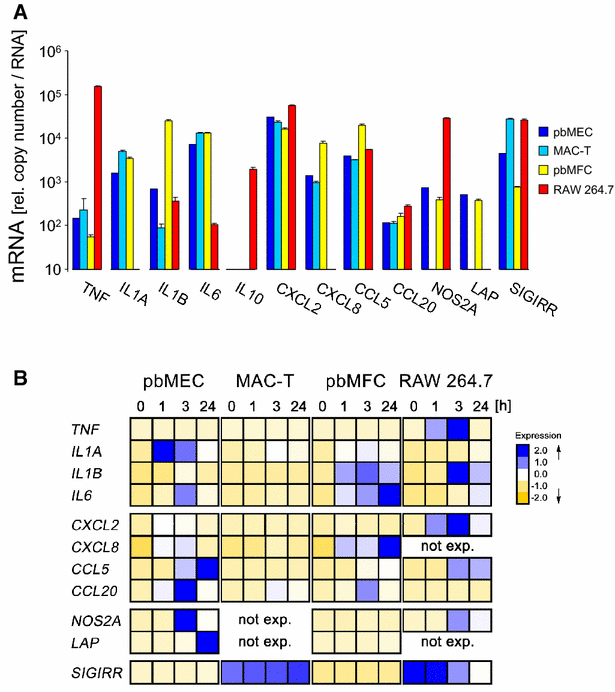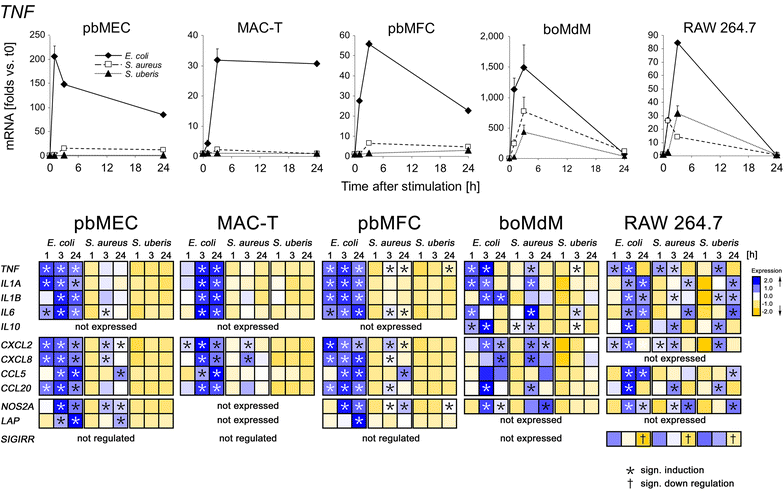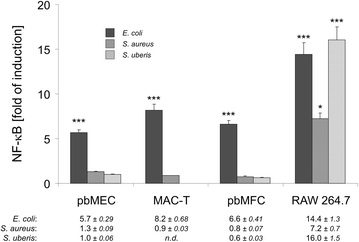Comparison of the pathogen species-specific immune response in udder derived cell types and their models
- PMID: 26830914
- PMCID: PMC4736154
- DOI: 10.1186/s13567-016-0307-3
Comparison of the pathogen species-specific immune response in udder derived cell types and their models
Abstract
The outcome of an udder infection (mastitis) largely depends on the species of the invading pathogen. Gram-negative pathogens, such as Escherichia coli often elicit acute clinical mastitis while Gram-positive pathogens, such as Staphylococcus aureus tend to cause milder subclinical inflammations. It is unclear which type of the immune competent cells residing in the udder governs the pathogen species-specific physiology of mastitis and which established cell lines might provide suitable models. We therefore profiled the pathogen species-specific immune response of different cell types derived from udder and blood. Primary cultures of bovine mammary epithelial cells (pbMEC), mammary derived fibroblasts (pbMFC), and bovine monocyte-derived macrophages (boMdM) were challenged with heat-killed E. coli, S. aureus and S. uberis mastitis pathogens and their immune response was scaled against the response of established models for MEC (bovine MAC-T) and macrophages (murine RAW 264.7). Only E. coli provoked a full scale immune reaction in pbMEC, fibroblasts and MAC-T cells, as indicated by induced cytokine and chemokine expression and NF-κB activation. Weak reactions were induced by S. aureus and none by S. uberis challenges. In contrast, both models for macrophages (boMdM and RAW 264.7) reacted strongly against all the three pathogens accompanied by strong activation of NF-κB factors. Hence, the established cell models MAC-T and RAW 264.7 properly reflected key aspects of the pathogen species-specific immune response of the respective parental cell type. Our data imply that the pathogen species-specific physiology of mastitis likely relates to the respective response of MEC rather to that of professional immune cells.
Figures



References
-
- Schukken YH, Günther J, Fitzpatrick J, Fontaine MC, Goetze L, Holst O, Leigh J, Petzl W, Schuberth HJ, Sipka A, Smith DGE, Quesnell R, Watts J, Yancey R, Zerbe H, Gurjar A, Zadoks RN, Seyfert HM. Host-response patterns of intramammary infections in dairy cows. Vet Immunol Immunopathol. 2011;144:270–289. doi: 10.1016/j.vetimm.2011.08.022. - DOI - PubMed
Publication types
MeSH terms
LinkOut - more resources
Full Text Sources
Other Literature Sources
Medical

